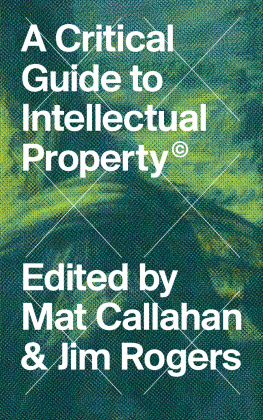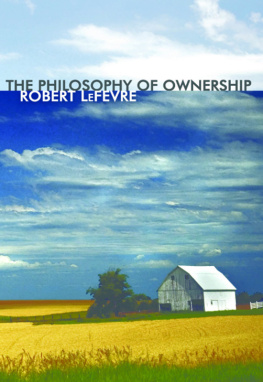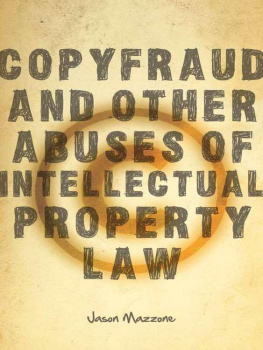Schur - Parodies of Ownership: Hip-Hop Aesthetics and Intellectual Property Law
Here you can read online Schur - Parodies of Ownership: Hip-Hop Aesthetics and Intellectual Property Law full text of the book (entire story) in english for free. Download pdf and epub, get meaning, cover and reviews about this ebook. year: 2018, publisher: The University of Michigan Press and The University of Michigan Library, genre: Politics. Description of the work, (preface) as well as reviews are available. Best literature library LitArk.com created for fans of good reading and offers a wide selection of genres:
Romance novel
Science fiction
Adventure
Detective
Science
History
Home and family
Prose
Art
Politics
Computer
Non-fiction
Religion
Business
Children
Humor
Choose a favorite category and find really read worthwhile books. Enjoy immersion in the world of imagination, feel the emotions of the characters or learn something new for yourself, make an fascinating discovery.
Parodies of Ownership: Hip-Hop Aesthetics and Intellectual Property Law: summary, description and annotation
We offer to read an annotation, description, summary or preface (depends on what the author of the book "Parodies of Ownership: Hip-Hop Aesthetics and Intellectual Property Law" wrote himself). If you haven't found the necessary information about the book — write in the comments, we will try to find it.
Schur: author's other books
Who wrote Parodies of Ownership: Hip-Hop Aesthetics and Intellectual Property Law? Find out the surname, the name of the author of the book and a list of all author's works by series.
Parodies of Ownership: Hip-Hop Aesthetics and Intellectual Property Law — read online for free the complete book (whole text) full work
Below is the text of the book, divided by pages. System saving the place of the last page read, allows you to conveniently read the book "Parodies of Ownership: Hip-Hop Aesthetics and Intellectual Property Law" online for free, without having to search again every time where you left off. Put a bookmark, and you can go to the page where you finished reading at any time.
Font size:
Interval:
Bookmark:
 Page i Page ii Page iii
Page i Page ii Page iii Hip-Hop Aesthetics and Intellectual Property Law
Richard L. Schur
The University of Michigan Press AND
The University of Michigan Library
ANN ARBOR
Copyright by Richard L. Schur 2009
Some rights reserved

This work is licensed under the Creative Commons Attribution-Noncommercial-No Derivative Works 3.0 United States License. To view a copy of this license, visit http://creativecommons.org/licenses/by-nc-nd/3.0/ or send a letter to Creative Commons, 171 Second Street, Suite 300, San Francisco, California, 94105, USA.
Published in the United States of America by
The University of Michigan Press and
The University of Michigan Library
Manufactured in the United States of America Printed on acid-free paper
Printed on acid-free paper
2012 2011 2010 2009 4 3 2 1
A CIP catalog record for this book is available from the British Library.
Library of Congress Cataloging-in-Publication Data
Schur, Richard L.
Parodies of ownership : hip-hop aesthetics and intellectual
property law / Richard L. Schur.
p. cm.
Includes bibliographical references and index.
ISBN-13: 978-0-472-07060-2 (cloth : alk. paper)
ISBN-10: 0-472-07060-6 (cloth : alk. paper)
ISBN-13: 978-0-472-05060-4 (pbk : alk. paper)
ISBN-10: 0-472-05060-5 (pbk. : alk. paper)
1. African AmericansLegal status, laws, etc. 2. Intellectual propertyUnited States. 3. Hip-hopInfluence. 4. African Americans in popular culture. I. Title.
KF4757.S38 2009
346.730482dc22 2009004565
Portions of were previously published as part of Stomping the Blues No More? Hip Hop Aesthetics and Contemporary African American literature, in Lovalerie King and Linda Selzer's edited collection, New Essays on the African American Novel: From Hurston and Ellison to Morrison and Whitehead (Palgrave 2008). Those sections have been reprinted here by permission.
ISBN-13 978-0-472-02449-0 (electronic)
Page vThrough her camera, Martha Cooper captured much of the energy of the emerging hip-hop scene during the late 1970s and early 1980s. Cooper, a white photographer for the New York Post, gained entrance into graffiti culture and was provided an opportunity to document the birth of hip-hop. Her work depicts them training, practicing, and ultimately performing. These shots also provide evidence of how New York City was suffering from neglect and decay even as these early hip-hop pioneers were laying the foundation for a new cultural aesthetic.
Cooper documents, among other things, how property, cultural ownership, and materialism, in various forms, have shaped hip-hop culture. Cooper's photography portrays graffiti artists acquiring paint and canvases by whatever means possible and documents the disintegration of the Bronx and other boroughs. It also depicts how young people sought to reclaim a form of ownership over their crumbling communities. In retrospect, these photographs highlight battles over public space, private property, and intellectual property. Although the City of New York criminalized the participants, Page vi graffiti art, break-dancing, and deejays, at their best, sought to beautify a decaying urban landscape and create public spaces for postCivil Rights era youth to enjoy the freedoms for which the Civil Rights Movement fought so gallantly.
These early elements of hip-hop culture quickly entered both mainstream and elite cultures. Break-dancing, due to MTV's emergence and the immense popularity of Michael Jackson, found adherents across the country and in many suburban communities. Graffiti art also soon merged into the New York art scene as graffiti writers, including Lee Quinones and Fab Five Freddy, became the subject of gallery shows during the early 1980s. Jean-Michel Basquiat, who gained as much or more celebrity in the art world than in the world of hip-hop, transformed graffiti into an elite art and soon became associated with Andy Warhol and other New York artists. Prefiguring intellectual property law's conflict with hip-hop, his work from the early 1980s frequently included ironic usages of copyright and trademark symbols. Richard Marshall argues that the is Basquiat's stamp of approval, authority, ownership, and originality. He further observes that by symbolically copyrighting his SAMO sayings, Basquiat was not just identifying them as his own, but sarcastically commenting on the obsession with legitimacy, ownership, and authorship, even of his often cryptic, subversive, and anti-ownership phrases. Long before sampling became the subject of copyright disputes, hip-hop aesthetes, like Basquiat, examined who owned American culture and how the distribution of property and putatively color-blind property law doctrines operated to produce racial inequalities.
Hip-hop would soon expand beyond New York and the United States. Although it has relatively quickly become a key element of youth culture worldwide and a form of mass or corporate culture, its initial concerns with ownership, property, and materialism remain integral elements of hip-hop. Hip-hop culture continues to provide a running dialogue, albeit sometimes confusing, contradictory, and highly metaphorical, about the material conditions of African American life and the relationship of Black America to American society and culture. The term hip-hop aesthetics denotes how these issues shape the content and form of contemporary African American cultural texts. My examination of hip-hop aesthetics seeks to explain the relationships among postCivil Rights era art, literature, and music and view them as interrelated phenomena. By privileging artistic and literary texts in my account, I hope to transcend the debates about hip-hop lyrics, especially their violence and sexism, and focus on the underlying aesthetic strategies that shape their production.
Page viiAnother purpose of this book is to try to make some sense of the confused debate about property, property rights, and materialism in the postCivil Rights era. Law, economics, cultural studies, and the arts all lay claim to these words, and no one book could synthesize all these usages. Scholars have most frequently viewed this conflict as pitting hip-hop music, especially with its reliance on sampling, against copyright law's understanding of fair use. In part because this is well-worn territory, and because I thought this narrow focus has unintentionally omitted some key elements of the story, I have broadened the conflict to examine a wider range of visual and textual production and to provide an occasion to speculate in a more philosophical tone (as opposed to a doctrinal one) about the purposes and effects of intellectual property law. As I hope this book makes clear throughout, intellectual property law is not the sole or primary influence shaping contemporary African American cultural production. Rather, it has become one of the key contemporary battlegrounds for a wide range of social, cultural, economic, and political questions.
In its effort to synthesize the vibrant conversations around intellectual property this book, engaging in a thought experiment of sorts, asks what insights could be gleaned if we viewed hip-hop aesthetics and African American cultural history, more generally, through the lens of intellectual property law (with occasional slippages into property law) and if we imagined what intellectual property law might look like if it tried to use copyright and trademark regulations to create a more just circulation of racialized texts. Obviously, these questions are artificial ones, because neither legal nor cultural texts can be so neatly isolated. The real world is infinitely more complex. That being fully admitted, this thought experiment helps sheds light on how the mind-sets or worldviews promoted by hip-hop and intellectual property law conflict at a conceptual or theoretical level and further the contemporary racial divide.
Font size:
Interval:
Bookmark:
Similar books «Parodies of Ownership: Hip-Hop Aesthetics and Intellectual Property Law»
Look at similar books to Parodies of Ownership: Hip-Hop Aesthetics and Intellectual Property Law. We have selected literature similar in name and meaning in the hope of providing readers with more options to find new, interesting, not yet read works.
Discussion, reviews of the book Parodies of Ownership: Hip-Hop Aesthetics and Intellectual Property Law and just readers' own opinions. Leave your comments, write what you think about the work, its meaning or the main characters. Specify what exactly you liked and what you didn't like, and why you think so.










